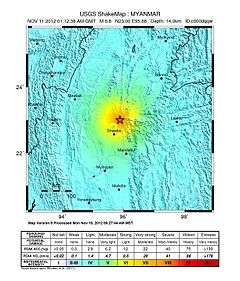2012 Shwebo earthquake
The 2012 Shwebo earthquake occurred at 07:42 local time (01:12 UTC) on 11 November in Myanmar. It had a magnitude of 6.8 on the moment magnitude scale and a maximum perceived intensity of VIII (Severe) on the Mercalli intensity scale.[2] The epicenter was near the town of Male, 52 km NNE of the city of Shwebo, 64 km west of Mogok and 120 km north of Mandalay. Significant damage and possible casualties have been reported from near the epicenter, with up to 26 people dead and many more injured. Part of a bridge under construction fell into the Irrawaddy River near Shwebo and a gold mine collapsed at Sintku.[3] [4] An aftershock with a magnitude of 5.8 followed at 17:24 local time (10:54 UTC).[5]
 | |
| UTC time | 2012-11-11 01:12:40 |
|---|---|
| ISC event | 601885134 |
| USGS-ANSS | ComCat |
| Local date | 11 November 2012 |
| Local time | 07:42:40 MMT |
| Magnitude | 6.8 Mw |
| Depth | 9.8 km (6 mi) |
| Epicenter | 23.014°N 95.883°E |
| Areas affected | Burma |
| Max. intensity | VIII (Severe) |
| Casualties | 26 dead + 12 missing[1] |

Tectonic setting
Central Burma lies within the complex zone of collision between the Indo-Australian Plate and the Eurasian Plate. In this area the collision is highly oblique and much of the plate convergence is accommodated by right lateral strike slip faults, of which the largest is the north-south trending Sagaing Fault, which takes up 18mm per year of this movement.[6]
Earthquake
The earthquake was caused by right lateral movement on the Sagaing Fault between Singu and Tagaung, with a rupture length of 60–70 km, and was followed by three large (M≥5) aftershocks in the area south of the mainshock epicenter,[7] and one to the north.[8]
Damage
Many buildings, including monasteries, pagodas, a hospital, and a school collapsed in Male and neighbouring villages. Damage was also reported from Shwebo, Mogok and Mandalay.[7] The Radana Thinga Bridge, which was still under construction, fell into the Irrawaddy River, and several workers went missing.[9]
References
- Bangkok Post (13 November 2012). "Myanmar quake's death toll rises". Bangkok Post. Retrieved 19 November 2012.
- United States Geological Survey (11 November 2012). "M6.8 – 52km NNE of Shwebo, Myanmar". Retrieved 11 November 2012.
- "Burma earthquake leaves at least 12 feared dead". The Guardian. London. 11 November 2012. Retrieved 13 May 2013.
- BBC (11 November 2012). "Burma earthquake: At least 12 feared dead". BBC News. Retrieved 11 November 2012.
- USGS. "M5.8 – 29km NE of Shwebo, Myanmar". United States Geological Survey. Retrieved 11 November 2012.
- USGS (12 May 2012). "Magnitude 6.9 – MYANMAR:Earthquake Summary". United States Geological Survey. Archived from the original on 30 June 2011. Retrieved 11 November 2012.
- Myanmar Earthquake Committee (11 November 2012). "Male (မလယ္) Earthquake (11-11-2012), Myanmar". Retrieved 11 November 2012.
- USGS (11 November 2012). "M5.6 – 62km WNW of Mogok, Myanmar". United States Geological Survey. Retrieved 11 November 2012.
- Aung Hla Tun (11 November 2012). "Strong quake in central Myanmar kills at least six". Reuters. Retrieved 11 November 2012.
External links
- The International Seismological Centre has a bibliography and/or authoritative data for this event.